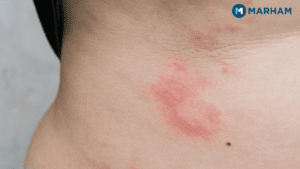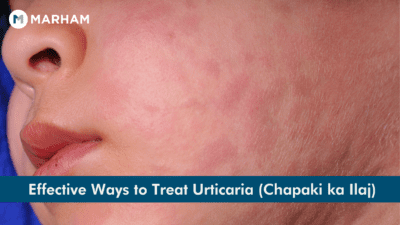Chapaki is a medical skin condition in which itchy and raised rashes form on the skin. They are generally pink, red, or flesh-colored on the light skin. However, on the brown or black skin, they appear as flesh-colored or slightly darker and lighter than the skin.
Chapaki hurts or stings sometimes. It is caused by any allergic reaction triggered by a food or medication or any irritant in the environment.
In most cases, chapati is a temporary skin issue in which rashes go away on their own or with any allergy medicine. On the other hand, in chronic cases, they are accompanied by a severe allergic reaction.
Chapaki affects approximately 20% of people at some time in their lives.
If you have the same condition, then you are in the right place. We have highlighted the best and most effective ways to treat chapaki (chapaki ka ilaj). Moreover, we have also looked at the causes, symptoms, and chapaki meaning in English.
Chapaki in English
Chapaki in English is known as Urticaria or Hives. In Urdu, it is written as چھپاکی.
Other than Urticaria or Hives, chapaki in English is also known as weals, welts, or nettle rash.
Urticaria Causes
Sometimes to cause of hives is not clear. However, urticaria (chapaki) is generally caused by an allergic reaction to something you have swallowed, inhaled, or encountered.
When the body has an allergic reaction, it starts to release histamines in the blood. Histamines are chemicals the body releases in an attempt to defend itself against the infection or antigens. In some people, histamines can cause itching, swelling, and other hives symptoms.
Some of the major things from which Urticaria can occur are as follows:
- Allergens
- Foods
- Medications
- Physical Triggers
- Reaction to Medication
- Sun exposure
- Changes in temperature
- Underlying health conditions (viral or bacterial infections, autoimmune disorders, etc)
- Additives, etc
Urticaria Symptoms
Some of the common symptoms of Urticaria (Chapaki ki alamat) are as follows:
- Itchy and raised bumps on the skin (the size of a pinprick to several inches)
- Bumps can be small and round shaped or large and of random shape
- Bumps that have a pale center when they are pressed
- Red, pink, or skin-colored bumps
- Bumps that come and go quickly, usually within 24 hours
Chapaki (hives) do not always appear as bumps. They can also be in the form of:
- Lesions
- Blotches
- Tiny spots
- Thin and raised lines
Loratadine Tablet: Uses, Side Effects, and Price in Pakistan
Where Do Hives Appear on the Skin?
- Face
- Legs
- Arms
- Trunk


Effective Ways to Treat Urticaria (Chapaki ka Ilaj)
There are two types of Urticaria, including:
- Acute Urticaria (Temporary) – lasts less than 6 weeks.
- Chronic Urticaria (Long Term) – lasts more than 6 weeks.
Based on the type of urticaria, the treatment (Chapaki ka ilaj) is suggested.
Hives – Symptoms, Causes and Prevention
Here is how you can effectively treat acute and chronic Urticaria (Chapaki ka ilaj):
1. Acute Urticaria
Acute urticaria is a short-term condition which lasts less than 6 months. In most cases, it goes away on its own. Since Histamine is the protein that causes the allergic reaction; therefore, to treat acute Urticaria oral second-generation antihistamines are generally prescribed.
Some of the commonly prescribed anti-histamines are as follows:
- Cetirizine
- Loratadine
- Bilastine
- Levocetirizine
- Desloratadine
- Fexofenadine
- Rupatadine
First-line antihistamines are not recommended as they pose many side effects.
Apart from the antihistamines, some other options can also be availed to treat the condition, which are as follows:
- Soothing creams to reduce itchiness
- Short-term use of topical steroids
- Antiseptic creams to prevent a secondary infection
Some people also used homeopathic medicine for Urticaria.
شدید چھپاکی ایک قلیل مدتی حالت ہے جو 6 ماہ سے کم رہتی ہے۔ زیادہ تر معاملات میں، یہ خود ہی چلا جاتا ہے. چونکہ ہسٹامین وہ پروٹین ہے جو الرجک رد عمل کا سبب بنتا ہے۔ لہذا، شدید چھپاکی کے علاج کے لیے زبانی دوسری نسل کی اینٹی ہسٹامائنز عام طور پر تجویز کی جاتی ہیں۔
اینٹی ہسٹامائنز کے علاوہ، اس حالت کے علاج کے لیے کچھ دوسرے آپشنز بھی استعمال کیے جا سکتے ہیں، جو درج ذیل ہیں:
- خارش کو کم کرنے کے لیے آرام دہ کریم
- ٹاپیکل سٹیرائڈز کا قلیل مدتی استعمال
- ثانوی انفیکشن کو روکنے کے لیے اینٹی سیپٹیک کریم
Note: All medicines should be taken as prescribed by the doctor.
2. Chronic Urticaria
If anyone has chronic urticaria, he/she may need to take antihistamines regularly until the symptoms go away.
For chronic Urticaria, a distinct way is preferred as many complications may occur.
- Omalizumab is an injectable drug that blocks immunoglobulin E (a substance that plays a role in allergic responses).
- Antibiotics that can lessen redness and inflammation.
- For a natural approach, Acupuncture is also effective.
اگر کسی کو دائمی چھپاکی ہے، تو اسے علامات دور ہونے تک باقاعدگی سے اینٹی ہسٹامائن لینے کی ضرورت پڑ سکتی ہے۔
دائمی چھپاکی کے لیے، ایک الگ طریقہ کو ترجیح دی جاتی ہے کیونکہ بہت سی پیچیدگیاں ہو سکتی ہیں۔
- اومالیزوماب ایک انجیکشن قابل دوا ہے جو امیونوگلوبلین ای (ایک مادہ جو الرجک ردعمل میں کردار ادا کرتی ہے) کو روکتی ہے۔
- اینٹی بائیوٹکس جو لالی اور سوزش کو کم کرسکتی ہیں۔
- قدرتی نقطہ نظر کے لئے، ایکیوپنکچر بھی مؤثر ہے.
Note: All medicines should be taken as prescribed by the doctor.
3. Home Remedies for Urticaria (Chapaki ka Gharelu Ilaj)
- Avoid using hypoallergenic detergents and soaps
- Go for soaps, detergents, and moisturizers that are for sensitive skin only
- Take a cold shower
- Avoid exposure to sunlight, UV light, and other physical triggers
- Avoid medicines that can trigger the condition
- Avoid foods that cause an allergic reaction
- Avoid wearing tight clothes
- Avoid stress
- Avoid scratching the affected skin area
- Wear light, loose, cotton clothes
- Use a cool compress or soothing lotion
چھپاکی کے علاج کا بہترین گھریلو علاج محرکات سے بچنا ہے۔ محرکات حالت کو خراب کر سکتے ہیں۔ لہذا، سب سے پہلے ان کی شناخت اور ان سے بچنا ضروری ہے۔
چھپاکی کے چند عام گھریلو علاج درج ذیل ہیں:
- hypoallergenic صابن کے استعمال سے پرہیز کریں۔
- صابن، ڈٹرجنٹ اور موئسچرائزر استعمال کریں جو صرف حساس جلد کے لیے ہیں
- ٹھنڈا شاور لیں۔
- سورج کی روشنی اور دیگر جسمانی محرکات کی نمائش سے گریز کریں۔
- ایسی دوائیوں سے پرہیز کریں جو حالت کو متحرک کرسکتی ہیں۔
- ایسی کھانوں سے پرہیز کریں جو الرجک رد عمل کا باعث بنیں۔
- تنگ کپڑے پہننے سے گریز کریں۔
- تناؤ سے بچیں۔
- جلد کے متاثرہ حصے کو کھرچنے سے گریز کریں۔
- ہلکے، ڈھیلے، سوتی کپڑے پہنیں۔
- ٹھنڈا کمپریس یا آرام دہ لوشن استعمال کریں۔
Can Urticaria be Prevented?
Simple lifestyle changes can help in preventing hives from reoccurring in the future.
- If you have allergies and know the substances that can cause an allergic reaction, then avoid exposure to those substances.
- Allergy shots can be taken to reduce to risk of hives reoccurring.
- Moreover, avoid being in high-humidity areas.
- Avoid wearing tight clothes if you have had a hives outbreak.
تھکاوٹ دور کرنے کے لیے 9 قدرتی اجزاء جو آپ نہیں جانتے (Fatigue)
Key Takeaways
Chapaki is a medical skin condition in which itchy and raised rashes form on the skin.
They are generally pink, red, or flesh-colored on the light skin. However, on the brown or black skin, they appear as flesh-colored or slightly darker and lighter than the skin.
Urticaria treatment (Chapaki ka ilaj) is possible and depends on the type of Urticaria you have.
By following certain home remedies and avoiding triggers, you can overcome the acute condition on your own. However, chronic conditions can be treated with medications.
If you have any skin disease, including Urticaria (chapaki), then consult the best dermatologist in Pakistan via Marham. You can book a video or in-clinic consultation with any dermatologist in Pakistan.
Frequently Asked Questions (FAQs)
1. What is the best treatment for urticaria?
The best way to relieve symptoms of urticaria is to avoid its triggers. Moreover, using OTC antihistamine medicines can also ease itching and the condition.
2. Is Urticaria Contagious?
No. Hives (urticaria) are not contagious. The condition cannot spread from one person to another.
3. What is Chapaki disease?
Chapaki disease is a skin condition in which itchy, raised bumps form on the skin. They can be pink, red, or skin-colored bumps, rashes, or blotches on the skin.
4. Can urticaria be cured permanently?
Acute urticaria can be cured permanently. However, there is less possibility that neither professional treatment nor home remedies can permanently cure cholinergic urticaria.

